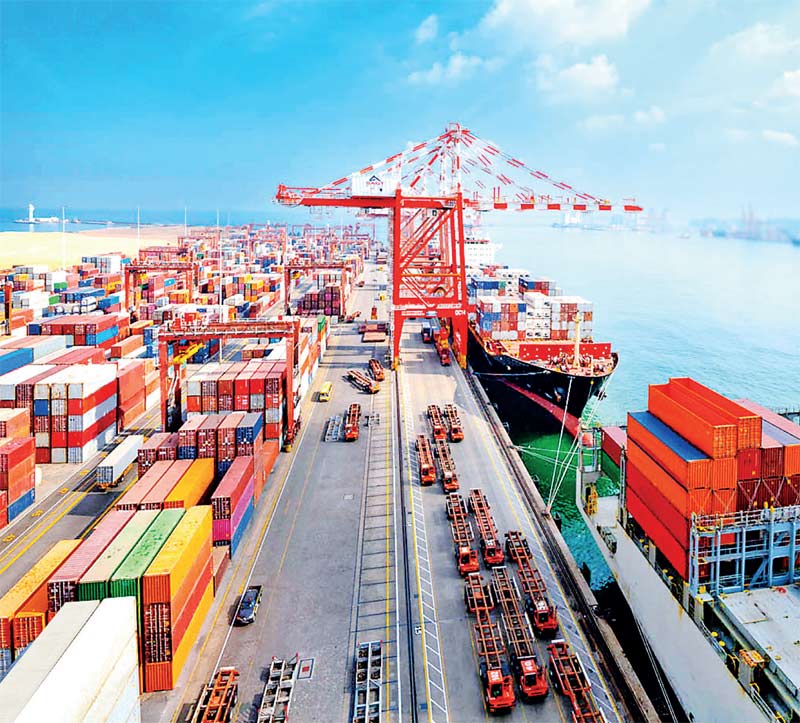Tuesday Mar 04, 2025
Tuesday Mar 04, 2025
Wednesday, 16 August 2023 00:00 - - {{hitsCtrl.values.hits}}

 South Asia Gateway Terminals (SAGT), Sri Lanka’s first Public Private Partnership and the Board of Investments (BOI) flagship project commenced operations in 1999, propelling the Port of Colombo as the pre-eminent gateway for global trade in the Indian Ocean.Now, twenty-four years on, SAGT continues to pioneer new frontiers for the Port of Colombo with the release of its fourth consecutive Sustainability report titled “An Unwavering Commitment to Sustainability”.
South Asia Gateway Terminals (SAGT), Sri Lanka’s first Public Private Partnership and the Board of Investments (BOI) flagship project commenced operations in 1999, propelling the Port of Colombo as the pre-eminent gateway for global trade in the Indian Ocean.Now, twenty-four years on, SAGT continues to pioneer new frontiers for the Port of Colombo with the release of its fourth consecutive Sustainability report titled “An Unwavering Commitment to Sustainability”.
The report accredited by globally acclaimed DNV (www.dnv.in) is the only such report released in the Port of Colombo and remains the only one by a single container terminal operator in the region.
Since its inception, SAGT has regularly featured the Port of Colombo on the global stage with international awards for operational best practices, work-safe initiatives and quayside efficiency.
A prominent global award bestowed on SAGT was its recognition as being the most productive terminal in South Asia and the 4th best terminal in the world in its class.
Today, SAGT continues to be a pathfinder through game-changing operational initiatives that derive supply chain efficiencies for greater stakeholder value.
A notable post-pandemic initiative was SAGT’s award-winning online e-DA import container clearance process that transformed a decade-long labour and paper-intensive process overnight through digitalisation. Effectively empowering the importer and Customs House Agent (CHA) community to self-manage the SAGT gate pass without manual intervention 24/7/365. As simple as an airline passenger obtaining an e-boarding pass for a flight.
Safety and Sustainability are deeply embedded in the core of Team SAGT. Since the formalisation of SAGT’s sustainability strategy in 2018, SAGT has embarked on a journey to decarbonise terminal operations. Recognising the need for collective action, SAGT expanded its efforts beyond the physical limitations of the terminal’s boundaries. SAGT is leading the way towards decarbonisation within the Port of Colombo, underwriting the feasibility study by Greenstat Hydrogen for “greening” overall Port of Colombo operations in alignment with GOSL’s countrywide aspirations.
With IMO decarbonisation targets for shipping lines. SAGT is positioning itself with the exploration of “Cold ironing” an industry term for vessels being provided shore power when in port to reduce vessel emissions. The ultimate aim is to work in support of the overall maritime industry goal of reaching net zero by 2050. It is a commitment to collaborate and support SAGT’s customer’s aspirations in meeting net zero targets in line with IMO directives.
SAGT’s carbon emission reduction achievements over the past year were primarily through a reduction in scope 1 (direct consumption) carbon emissions. Team SAGT reduced its Scope 1 carbon emission through investing in advanced technology such as hybrid (battery and fuel powered) Rubber Tyred Gantry cranes (RTG) and optimising the utilisation of hybrid RTG’s in yard operations. This initiative alone saved 1,663,655 litres of diesel on RTG operations in 2022/23. Consequently, ensuring the reduction of 3,959 metric tonnes (MT) of carbon emissions from being released into the environment. To give perspective, the amount of diesel saved could power approximately 37 RTG’s for a period of one year based on prior year operating hours!
“An Unwavering Commitment to Sustainability” aptly charts a remarkable journey for SAGT. Maritime industry leadership as a proud organisation with majority Sri Lankan shareholders, SAGT continues to punch above its weight while presenting its global customers a value proposition beyond the Port of Colombo’s historical marker as being in a “strategic geographical location”.
SAGT is continuously driving innovation and improving business processes to make business greener, smarter, and more efficient enhancing a best-in-class service experience to its customers and its customer’s customers.
Discover Kapruka, the leading online shopping platform in Sri Lanka, where you can conveniently send Gifts and Flowers to your loved ones for any event including Valentine ’s Day. Explore a wide range of popular Shopping Categories on Kapruka, including Toys, Groceries, Electronics, Birthday Cakes, Fruits, Chocolates, Flower Bouquets, Clothing, Watches, Lingerie, Gift Sets and Jewellery. Also if you’re interested in selling with Kapruka, Partner Central by Kapruka is the best solution to start with. Moreover, through Kapruka Global Shop, you can also enjoy the convenience of purchasing products from renowned platforms like Amazon and eBay and have them delivered to Sri Lanka.
Discover Kapruka, the leading online shopping platform in Sri Lanka, where you can conveniently send Gifts and Flowers to your loved ones for any event including Valentine ’s Day. Explore a wide range of popular Shopping Categories on Kapruka, including Toys, Groceries, Electronics, Birthday Cakes, Fruits, Chocolates, Flower Bouquets, Clothing, Watches, Lingerie, Gift Sets and Jewellery. Also if you’re interested in selling with Kapruka, Partner Central by Kapruka is the best solution to start with. Moreover, through Kapruka Global Shop, you can also enjoy the convenience of purchasing products from renowned platforms like Amazon and eBay and have them delivered to Sri Lanka.